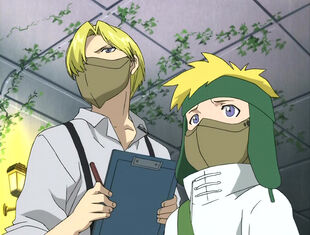This year, the first anime adaptation of Hiromu Arakawa's legendary Fullmetal Alchemist manga turns 15 years old. The 2008 remake, Brotherhood, has eclipsed its predecessor in terms of popularity and critical acclaim, but is the 2003 edition still a good show? Each series will not be compared in this review - rather, we'll be evaluating 2003's Fullmetal Alchemist solely as an adaptation of the source material.
As many fans of the franchise are aware, the Fullmetal Alchemist anime began only months after the manga started. This meant that the production studio, Bones, had little material to work with, so they decided not to follow Arakawa's books panel-to-panel from start to finish. Instead, the anime ended up being a loose adaptation of the first eight volumes, with an original ending.
Compared to the manga, the plot is very slow. Many of the major story beats are still there, but there are greater gaps between them, and not everything feels as if it drives the plot like the manga's story does. This does leave room for good character moments, but a lot of the new story elements feel shallow and unnecessary. Some of the anime-original characters and events do play a role in setting up the anime's ending, however.
Major differences in plot begin to emerge around halfway through the anime, and the freedom that anime writer Sho Aikawa has comes with its ups and downs. A real strength that this show has over the manga is that the villains of the story, the homunculi, have more opportunity for development. The reason they exist is different to Arakawa's version, and allows the viewer to sympathise with them a lot more. Two of the homunculi, Wrath (name switched with the manga's Pride) and Sloth, are entirely different characters and may even be more interesting than their counterparts in the source material.
While the secondary antagonists in the anime are compelling, however, the main villain is relatively weak. Their motivation is uninteresting and they are overshadowed by the homunculi in terms of overall importance. Edward and Alphonse's final confrontation with this enemy has weight, but it doesn't quite feel like the big conclusion that everything has been leading up to. In fact, this villain is entirely absent from Conqueror of Shamballa, the feature-length film which serves as the "final episode".
Another weakness with the writing is the sheer amount of death. The manga had its fair share of brutal moments, but they were relatively scarce and thus had impact. There is so much death in the anime that it becomes desensitising - you begin to stop being as shocked when characters are bumped off.
One thing that cannot be faulted is how studio Bones brings the world of Fullmetal Alchemist to life. While the animation doesn't quite match up with Arakawa's art style, it looks good and still holds up today. Due to the bigger budget, the quality is highest in Conqueror of Shamballa, which has some truly beautiful shots. Michiru Oshima's soundtrack successfully sets the mood for each scene, and likely invokes nostalgia for those who watched the anime back when it first aired. And, of course, each of the four opening theme songs are incredibly catchy.
Funimation also deserve credit for giving this series an excellent English dub. Each voice actor is perfect for the character they play, and they pour emotion into each scene to make the characters and their experiences feel real. Try reading the manga without hearing Aaron Dismuke's adorable Alphonse voice after watching this.
At its core, the first Fullmetal Alchemist anime is the same story as the manga on which it it based: the coming-of-age tale of two boys trying to regain what they have lost. It follows this path slower than the source material, and ends up taking an entirely different route, but it is still a highly enjoyable and heartfelt adventure that all fans of the franchise should experience.
Rating: 7.5/10
Fullmetal Alchemist is available on Netflix, and you can watch the follow-up film Conqueror of Shamballa on Crunchyroll.




Comments
Post a Comment